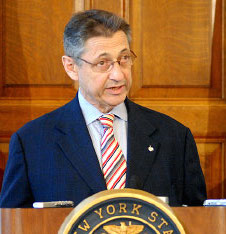
As more of the facts emerge about Proposal One on the Nov. 8 statewide ballot, New Yorkers are discovering that this attempt by Albany insiders to protect lawmakers’ paychecks and rewrite the state constitution is hardly the “reform” its supporters have made it out to be.
Since Prop One obviously has more loose ends than a cheap sweater, fans of the measure are now resorting to a series of fallback arguments in an attempt to attract votes. Here’s a summary, with comebacks:
“Of course it isn’t perfect, but it’s better than nothing.”
If only this were true. Unfortunately, no one denies that Prop One would shift more budget-making power to the same state Legislature whose secretive, undemocratic and wasteful ways have earned it the title of “most dysfunctional” in the nation. Putting these guys in the driver’s seat is worse than nothing.
“Predictions of “runaway spending’ under Prop One are exaggerated because the governor would still have a veto.”
Yes, once a new fiscal year begins, a governor would be able to veto any changes the Legislature makes to a “contingency budget” capped at the prior year ‘s level. But this cap would have major exceptions, including spending tied to federal aid.
The net effect of this language would be to put all or most Medicaid spending on autopilot, completely shielded from veto. And with the ability to rewrite other aspects of the contingency budget, the Legislature could undermine the governor’s veto power in numerous other ways.
“At least school districts will now have certainty about their level of funding even if the budget is late.”
This assertion is based on a provision of the amendment’s implementing statute that would appropriate school aid for two years at a time. But the law is so poorly drafted that it’s still not clear (a) whether two-year appropriations are actually allowed under the constitution, or (b) what the controlling school aid appropriation would be in a contingency budget.
Conversely, if this claim is correct, the single largest tax-funded portion of the budget also will be on autopilot if Prop One passes – which is hardly good news for taxpayers. The only real “certainty” stemming from the school aid provision will be the litigation that follows any attempt to implement it.
“Chances for constitutional reform don’t come around often in New York State.”
In fact, if Prop One fails, real reform will be just around the corner.
Legislators already have adopted their own fallback position – by passing another, more narrowly drawn constitutional amendment that actually would fix their biggest objection to last year’s Court of Appeals ruling upholding the governor’s budget-making authority.
Their first opportunity to put a new amendment on the ballot will be in 2007- the same year George Pataki’s successor takes office. A newly elected governor, armed with a fresh mandate to shake things up, will be in a strong position to demand that the next proposed constitutional change is paired with statutory budget reforms that really deserve broad public support.






